As a money blogger, I tend to get asked a lot of questions about money. Some financially focused queries land in my inbox, some are sent over social media, and others are fired at me while sitting in the hot seat of a live TV interview.
I love answering all sorts of questions on all kinds of channels, but sometimes (and I mean sometimes) the questions give me a serious case of the side-eyes. Basically, the questioner wants to know how low I’ll go to save a buck. Ugh.
Cheap shots I’ve saved throughout the years:
Questioner: “What’s it like being cheap?”
Me: I wouldn’t know. My friends would likely say I’m generous with both my time and money.Questioner: “What’s the craziest thing you’ve done to save money?”
Me: I once set up a monthly automatic transfer from my chequing account to my savings. I haven’t touched it since.Questioner: “Would you flip your underwear inside out to save money on laundry?”
Me: I’ve rescued a wedgie at least once, but I’ve never flipped my thong. No.
Your bottom line doesn’t have to involve freshly laundered panties to answer the cheapness question. In my lifestyle of living frugally and embracing thrift there’s a big Big BIG (three bigs) world of difference between being frugal and being cheap.
Take the frugality test by answering these cheapness questions to see for yourself.
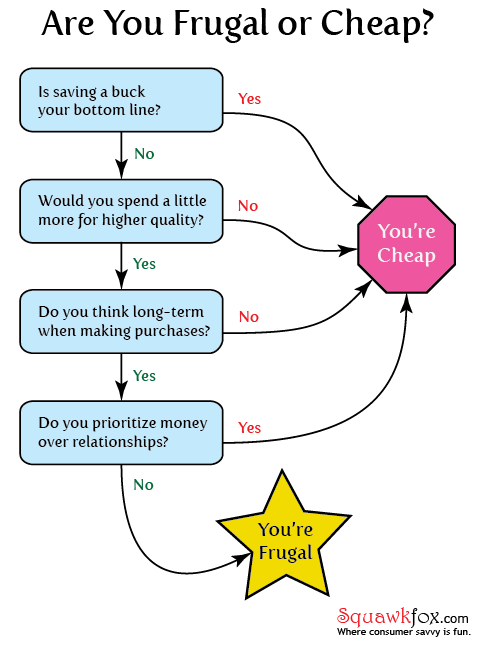
What’s the difference between frugality and cheapness?
A lot.
Cheap people use cost as their bottom line. You’re cheap if you don’t look beyond nickels and dimes. Frugal or thrifty folk seek value when spending money and often choose to spend more when an item’s quality and longevity are important.
For example, remember when I declared my $783 unlocked iPhone a ringin’ deal? Before locking myself into an inflexible cell contract with a subsidized $213 phone I did the math.
I compared cell phone plans in a spreadsheet and found that paying $783 outright for my iPhone and going on a prepaid plan would save me at least $1,760 in the long term. Paying more upfront to save significantly over three years was my frugal choice. The math doesn’t lie.
How about that $700 Canada Goose puffy parka? Many commented that $700 was far too much to spend, and a comparable winter coat without the big brand name could keep a shivering mammal warm for significantly less money. That’s a fair argument, sure. But what about the people who stand by the costly coat because of the Canadian-made quality, the durable fabrication, and the fact that they’ve worn their Canada Goose parkas for years? These coats ain’t cheap, but are they frugal? This scenario is harder to quantify since it depends a little more on personal choice.
So I ask you: How do you define frugality and cheapness? What’s your bottom line? And would you flip your underwear inside out to save money? Ugh.
Love,
Kerry
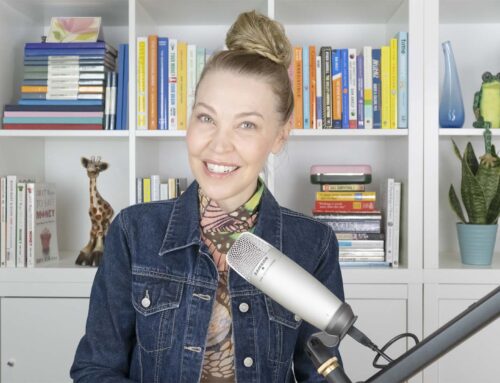
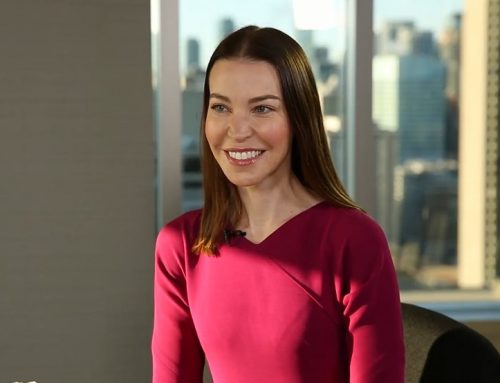
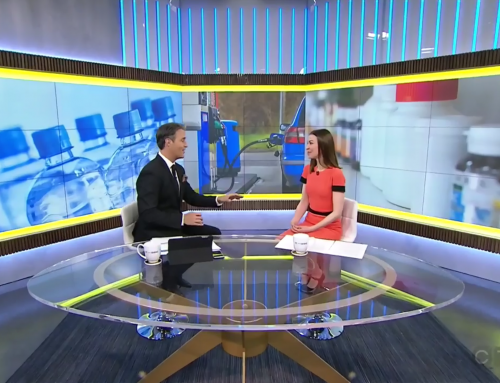

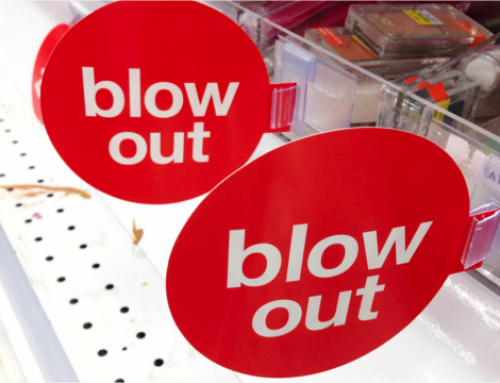
Your flow chart is a much better at indicating what our money behaviour means. Panty question: If they’re asking, either they did it themselves or they know someone who did….that’s not cheap nor frugal; it is just straight up gross.
(Welcome back kiddo!!)
I’m known for being cost conscious. But I definitely look for quality. And I’ll pay a premium for health.
Thank you Connie. It feels really good to write again. 🙂
Great to have you back, you have been missed!!!!
My kids always called me cheap because I would always buy large ticket items and consumables on sale knowing I would need them down the line, or not buy things on an impulse before shopping around and justifying to myself that I needed it. I always just considered it frugal and I get a good laught now 30 years later when they are furtively emulating my behavior but insist when confronted that it is not the same. Yeah ok.
Frugal/minimal is the way to go. No point buying a bunch of cheap things which wear out quickly, when one good quality thing which might cost more will do the trick!
Buy once; Cry once. I’m still using my Sear’s Craftsman tools from 40 years ago. They still honor their warranty.
So good to have you back!
I too will pay a premium for health. I seldom coupon because they are too often for crappy quasi-food and you couldn’t pay me enough, ever, to use Febreze, Glade or anything scented with petro-chemical derivatives.
And relationships trump!
Wahoo! Squawkfox in my inbox!
I heard the owner of Patagonia do an interview once, where he said “Poor people can’t afford cheap stuff.” I keep that in mind all the time when I’m buying things that I want/need to last a long time.
so glad to see you back, I clip coupons for things I use but will pay for good quality things that will last for many years. always buy on sale, just be patient.
and as for our needs, the stores are so full of junk that they try to convince us we “need” and we don’t…..
I choose to use “value” in evaluating items. The illustration of the $700 coat is perfect. Your purpose was to procure a coat that would meet your criteria of staying warm for than one season. With each continuing season the cost goes down.
The price tag is not always the bottom line. If I purchase an inferior product, and I replace that item several times, there is no value.
Welcome back! We missed you.
I’m afraid I’m going to be a contrarian here: I wouldn’t buy a $700 coat because I live in an area with assaults (happened to me) and I feel the “upscale” couture projects a moneyed exterior that would make me a bigger target.
Guilty as charged. Thanks for the wake up call Kerry
And welcome back. you were sorely missed!
Welcome back!!! We have missed you!!! I’d say I’m frugal. Due to the fact hubby had to take an early retirement because of health issues and I am caregiver here and the main driver so it is difficult to work outside the home. He gets a disability from the government and I have to stretch that as far as I can.we also have our two boys living at home. The older boy spent 8 years I. The military before being released on medical grounds(depression) and was later diagnosed with Asperger’s. The younger boy is looking for work but it isn’t easy in our small town.the older boy also gets a disability from the government but pays board. The younger boy will as soon as he finds something, as it is he does a lot around the house to help me out. Because I watch prices, shop sales, thrift stores and other second hand venues as well as coupon when i can to get the best bang for every buck some call me cheap. I have to watch that bottom line but I do find we do OK because I am so careful. I can get what we need through these methods without buying cheaper quality products. Consider it a system that I work to my best advantage for the benefit of my family….
Kerry
Great to read your articles again- missed you. Welcome back.
PS- it rocks to be frugal!
I’ll build/make/fix something rather than get store-bought simply because I know that it will be better. Does that make me cheap or frugal ?
In the case of my home, it was designed/built 30 years ago to exceed the then-new R-2000 performance standard, working mostly by myself and without taking out a mortgage. Not having a mortgage has saved me hundreds of thousands of dollars. Making it an energy-efficient/low-energy home has saved me six figures in energy costs. But it’s not the $$$ savings that matters to me. It’s the creature comfort and long-term sustainability that counts most.
In the case of little stuff like making my own panniers and racks for my bikes (on which I’ve put more kms than my autos (one of which is a 1985 Volvo estate wagon with less than 180k on it, the other being a 2006 Matrix that goes over 600 kms between fill-ups) annually for decades), they accommodate my needs better. ie Front carrier baskets that can handle bagsful of groceries or interesting chunks of granite that I discover on outings or rear panniers/racks than will carry a couple of pairs of snowshoes for when I ride deep into the bush for day treks.
Would I buy a Canada Goose Parka ? No. I can be warmer and more comfortable simply by layering clothing that I’ve had and used for the last 30-40 years.
Cheap ? Don’t think so. Frugal ? Perhaps.
Hurray! I’m frugal!
Glad I checked in with your site today. Hope you are doing well. 🙂
It’s a good day when I see something new from you in my inbox!!!
What a great topic! Of course don’t expect too many Cheapos to respond. Frugal (mostly) here and occasionally a wanton spendthrift.
Recently I bought a Vanity Fair to read while traveling and, although the articles were good, I was struck and disturbed by the advertising. So many over the top products which left me with a vague sense of unease that I don’t own any of them.
Somehow the advertisers got to me!!!
So, either I never buy that mag again or I tear out the first 80 pages.
Hope you are totally back up to speed. () () () (three hugs 😉 )
I don’t mind being called cheap. Although I mostly failed your graph and ended up at frugal. The only time I answered cheap was for spending more for quality. Many times I don’t need something to last forever, so I’ll buy the cheapest thing that can get the job done.
Yayy, you’re back! I was just thinking about you and the next time I’d see a witty post.
Hey, I was just thinking of you the other day and realized we haven’t heard from you in too long. I hope you are doing well. And yes, I’ve missed you. So glad to see you in my inbox today.
I also wouldn’t buy the $700 parka – I wouldn’t use it as we live in Texas and would absolutely burn up in it, even on our coldest days.
That aside, my husband and I were talking this past week about an outfit, a costume, that we made for him many years ago. It cost over $200, which was alot for us then (and now.) Yet, even if he wears it just once a year, that rings the cost down to $20 a year thus far, and it still has plenty of wear in it. As he said, you can’t rent this for that little! It isn’t always the bsic cost, but instead it’s the quality.
I read a magazine article lately that defined the difference between cheap, frugal and stupidly extravagant. Scenario: it’s a loved one’s birthday. The stupidly extravagant person blows a ton of money on a swanky restaurant dinner, an expensive wine and acts like it is ok…$300 or more later – all the while knowing they cannot afford it. A frugal person plans ahead,makes a delicious dinner at home to enjoy with a $15 bottle of wine. They have celebrated the birthday with a great meal that will not break the bank or their budget. A cheap person,ignores the birthday altogether in order to save the money. The cheap person can afford to do more…but chooses not to, preferring the bottom line over celebrating a loved one’s day of birth. Let’s all strive to be frugal!
I’m all about getting EXACTLY what I want for the lowest possible price. I research quality and longevity throwing price to the wind (for the most part) and then when I’ve settled on the exact thing I want, I go to work finding ways to get it for much less.
That’s my philosophy and I’m sticking to it. Great to see a post from you Kerry!
Great post. I think a lot of people have frugal and cheap mixed up, including, unfortunately, many so-called experts who advise people on how to “save money”. I always say that the less money you have, the more important it is to focus on quality, because you can’t afford to keep replacing cheap crap. Except for consumables, I rarely make a purchase unless I’m sure it will last for quite some time…if not for me, then for someone else who will buy it when I’m done. I’m about to sell a high-quality stroller for $150 that I bought over 6 years ago (I paid $350 on clearance).
Health and animal welfare are so important to me that those will trump frugality in some instances, i.e. I’ll pinch pennies in other areas so I can afford free range eggs and good quality dog food. I’m sure every person has a wavering point on the line that has cheap at one end and frugal on the other.I’m sure my homemade Christmas gifts are considered cheap in some quarters, and a truly frugal person would be appalled at how much I spend on 2 hairy dogs! And priorities change necessarily over time. I get to be really frugal with my transportation costs now that I’m not packing three kids around to soccer games! LOL
Always love to read your columns – so glad to see that you’re back!
I find it is easier to be frugal when I have absolutely no interest in the many ‘things’ that are being marketed. Foods sold as being faster to prepare/prepacks are usually not that much faster, and the quality is most likely compromised. How long does it take to slice open an apple and remove the seeds? Would you rather spend the extra 45 seconds to slice open a fresh fruit yourself or walk to the refrigerator and open a package of apple slices, which were probably sprayed/dipped in something to keep it from browning, and save 25 seconds? And no doubt pay more for it??
I prefer to be frugal and prepare foods from scratch as much as possible!
And on big purchases, agree with willing to pay more for better quality, esp if it has a better/longer warranty. We looked for months before deciding on which lawn tractor to purchase… We plan to not move again, and want it to last as long as we do! The final result was more expensive, but had 5 year vs 2 year warranty on some parts and lifelong on others. Plus the neighbors said the dealer we ended up with was well known for giving good service, as opposed to the more famous brand, when we visited they seemed like we were interrupting them, when we asked about the different models and they had to lay down the paper to take us outside…
Welcome back!
I am definitely frugal. I believe in paying for quality (if it makes sense)for many reasons – longevity of the product, how often I use it, I don’t want to support buying crap from China and also to help our beautiful planet by not buying cheap stuff that hits a landfill right away.
I bought a used Mini Cooper 4 yrs ago – the car is incredible. 8 yrs old, unbelievable on fuel and has never needed repairs and only requires an oil change once a year. Love it.
Welcome back! I used your article about the cell phone situation to convince my husband about buying our phones outright. He went through the roof at the cost but once I showed him how much we would save over time, he gave in. Now our cell phone bill for 2 phones with 4G and all the data, etc. is $109.00 a month compared to $180.00. Now mind you, I get a 24% discount through my employer as well. SCORE, DOUBLE SCORE!!!
Julie in OKlahoma
Kerry It sure is good to see you back. I missed your e-mails.
I am frugal which I take as a compliment.
Again it is really nice to see you writing again.
send the black dogs to the back of the class.
Delighted to see your voice back and strong. I am always frugal and hopefully never cheap, because anything I can share and give I am delighted to do so. Being careful in personal spending but generous (not crazy)in sharing is my definition of fugal vs cheap. All the cheap people I know would never think of giving freely and wholeheartedly. Your website is the definition of generous.
Thank you.
Love the flow chart–so true, so true!
One thing I have noticed over the years is that cheap people tend to whine about prices and lack of money non-stop when they are buying necessities; whereas, frugal people generally, make their modest purchase and if they talk about their purchase it usually is about their plans to maximize the item to get more bang for their buck.
Great to see you back!
I’m a frugalista for sure….most of the time.
Melanie
I am decidedly frugal, because being cheap costs too much!
When I first had a high-paying job a few years after university, I spent money like water on whatever caught my eye. I ended up recycling a lot of those clothes, books and costume jewelry to the resale shops as fast as I bought them. The next time I had a high-paying job, I had learned a lot about quality, and that’s what I bought. 12 years later, I am still wearing many of the clothes and jewelry and even some of the shoes I bought either at full price or on sale, and I am currently earning 1/4 of what my pay was on the most recent “high-paying job.” When I am compelled to buy, I go for the standard I have already set, and I can usually find it at a price I can pay.
My best example of the power of frugal is a pair of Bally of Switzerland shoes I bought while at my first high-paying job, almost 30 years ago; I recently had them resoled for the second time, and the trim redyed a dark navy from the original light tan. I should get another 15-20 years out of these fabulous, timeless spectator pumps, I estimate.
The moral of the story: Frugal can last forever, cheap seldom lasts a year.
Great to see you back in action Kerry!
I’m absolutely a frugal person… and proud of it!
Hi Kerry, so nice to see you back also. My husband was just mentioning Friday how he hasn’t see you around for a bit (I am a subscriber but he isn’t) hehe.
Thanks for your work and looking forward to read more of your posts. 🙂
Hurrah! You’re back! Missed ya!
Aaaaaand I’m mostly frugal. Mostly…
Kudos for posting again and at a time of year I find most challenging! People who ‘get it’ are precious. Welcome back and keep doing your doing. People who read your blog are all frugal, not a cheapie among them.
Sometimes people use “cheap” to mean “frugal things I’m not willing to do”, so I don’t mind calling myself cheap from time to time. If I don’t step out of my comfort zone every now and then, how will I know which of my current expenses are more than I need/want? I know somebody (Blake?) said you never know how much is enough until you know how much is too much, but it works on the “too little” side, too.
Yesterday I was shopping for a countertop at Home Depot with my teenage grandson. I was choosing the correct length and wanted something in the gray/black/white colour scheme. There were two that looked the same. I pulled them both out – one was $99.;the other$75 marked down. I chose the lower priced one. Just as we were heading to the checkout ,he loudly said,”Come on cheapskate.” The lady walking behind us looked totally blown away. She did’t know that he was teasing me. We had just been to the bike shop where he wanted to purchase a pair of matching tires to fix up his BMX to sell it. The store only had mismatched ones in the lower priced range. The only matching set was expensive. He got the store owner to sell them to him for $20 less because they were out of season. He watches his cash too.
Awesome! It’s good to know that I am frugal and not cheap. I definitely do prefer to pay for something that is higher quality as long as I know that it will work better than cheaper stuff and it worth it. Great article!
Frugal means to me that you make an active choice where to spend your money.
This comes down to minimizing your monthly regular spend to allow for a buffer you can utilize to do frugal shopping.
It’s similar to companies who need to invest money to complete a cost reduction program.
This can be achieved for instance by switching suppliers/insurance companies/etc. every year or make suppliers believe you are leaving, allowing them to make you a better offer. They reduce churn and you gain an lower monthly spend based upon the future value paradigm.
Once you have the money to spend it’s up to your personal preference what would be a frugal choice.
[…] Are you frugal or cheap? includes a great graphic that answers the question. Kerry’s flow chart reveals that you are definitely frugal and not just cheap if saving a buck is not your ultimate objective; you would spend a little more for higher quality; you think long-term when making purchases; and, you do not prioritize money over relationships. […]
I had one of those bank creditcards where you pay a $79 yearly fee but get better rewards than cards that are free. This past year I barely got enough “points” to cover the $79 fee so I called to cancel the card; they waived the fee!!
Late to the party, but… I’m both. partly it depends on what’s going on in my life; When I’m saving up to repair my car, I drink water even if it tastes bad (It’s safe city water). When I have even a few dollars not stretched to transparency, I buy a secondhand filter pitcher and a filter. But I will _not_ buy bottled water. I’d rather use a backpacker’s still on my apartment lawn.
Far too many people feel that saving money and being frugal means not owning nice things or the need to only own cheap stuff. There are some things that I don’t need to last forever and then there are those things that I actually would rather only spend money on once, so buying something quality makes sense. Also, when it comes to health/medical or things like decent footwear that save money/health down the line it’s an investment.